Yu Xi
Joint decoding method for controllable contextual speech recognition based on Speech LLM
Aug 12, 2025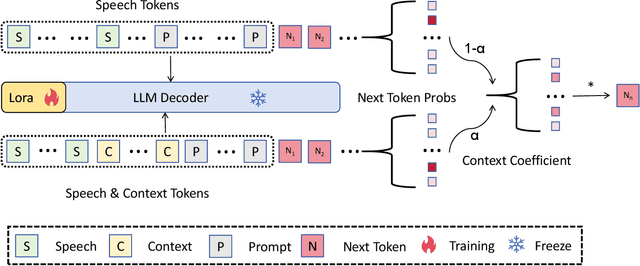
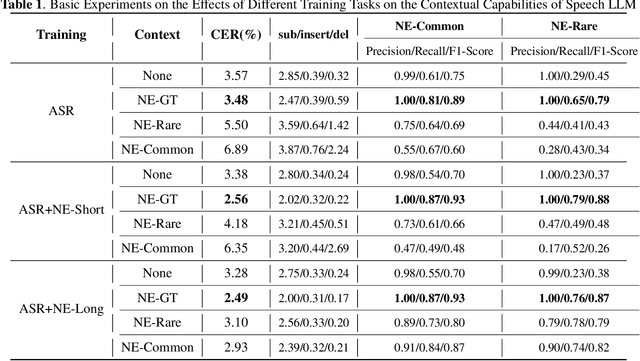
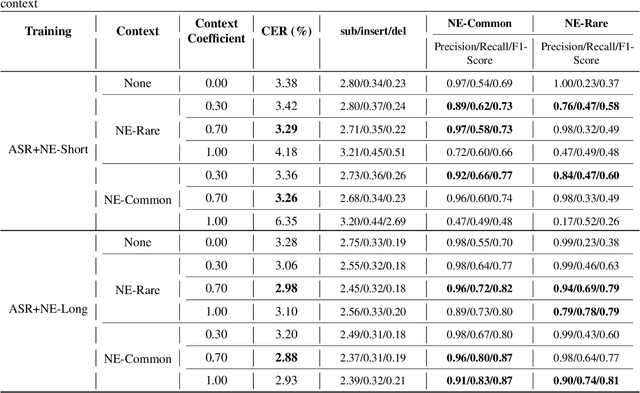
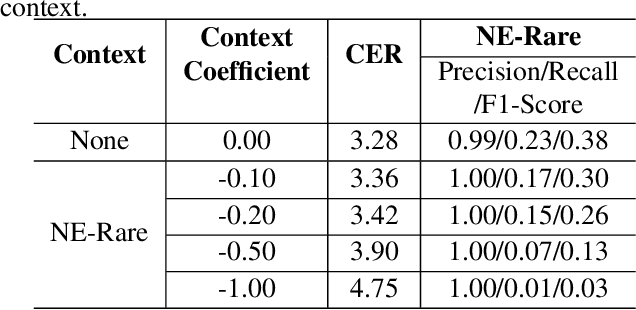
Abstract:Contextual speech recognition refers to the ability to identify preferences for specific content based on contextual information. Recently, leveraging the contextual understanding capabilities of Speech LLM to achieve contextual biasing by injecting contextual information through prompts have emerged as a research hotspot.However, the direct information injection method via prompts relies on the internal attention mechanism of the model, making it impossible to explicitly control the extent of information injection. To address this limitation, we propose a joint decoding method to control the contextual information. This approach enables explicit control over the injected contextual information and achieving superior recognition performance. Additionally, Our method can also be used for sensitive word suppression recognition.Furthermore, experimental results show that even Speech LLM not pre-trained on long contextual data can acquire long contextual capabilities through our method.
Low-Resource Domain Adaptation for Speech LLMs via Text-Only Fine-Tuning
Jun 06, 2025Abstract:Recent advances in automatic speech recognition (ASR) have combined speech encoders with large language models (LLMs) through projection, forming Speech LLMs with strong performance. However, adapting them to new domains remains challenging, especially in low-resource settings where paired speech-text data is scarce. We propose a text-only fine-tuning strategy for Speech LLMs using unpaired target-domain text without requiring additional audio. To preserve speech-text alignment, we introduce a real-time evaluation mechanism during fine-tuning. This enables effective domain adaptation while maintaining source-domain performance. Experiments on LibriSpeech, SlideSpeech, and Medical datasets show that our method achieves competitive recognition performance, with minimal degradation compared to full audio-text fine-tuning. It also improves generalization to new domains without catastrophic forgetting, highlighting the potential of text-only fine-tuning for low-resource domain adaptation of ASR.
Masked Self-distilled Transducer-based Keyword Spotting with Semi-autoregressive Decoding
May 30, 2025Abstract:RNN-T-based keyword spotting (KWS) with autoregressive decoding~(AR) has gained attention due to its streaming architecture and superior performance. However, the simplicity of the prediction network in RNN-T poses an overfitting issue, especially under challenging scenarios, resulting in degraded performance. In this paper, we propose a masked self-distillation (MSD) training strategy that avoids RNN-Ts overly relying on prediction networks to alleviate overfitting. Such training enables masked non-autoregressive (NAR) decoding, which fully masks the RNN-T predictor output during KWS decoding. In addition, we propose a semi-autoregressive (SAR) decoding approach to integrate the advantages of AR and NAR decoding. Our experiments across multiple KWS datasets demonstrate that MSD training effectively alleviates overfitting. The SAR decoding method preserves the superior performance of AR decoding while benefits from the overfitting suppression of NAR decoding, achieving excellent results.
Fewer Hallucinations, More Verification: A Three-Stage LLM-Based Framework for ASR Error Correction
May 30, 2025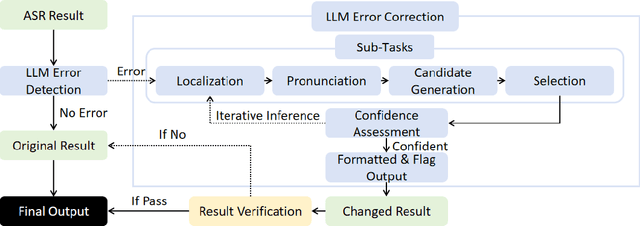
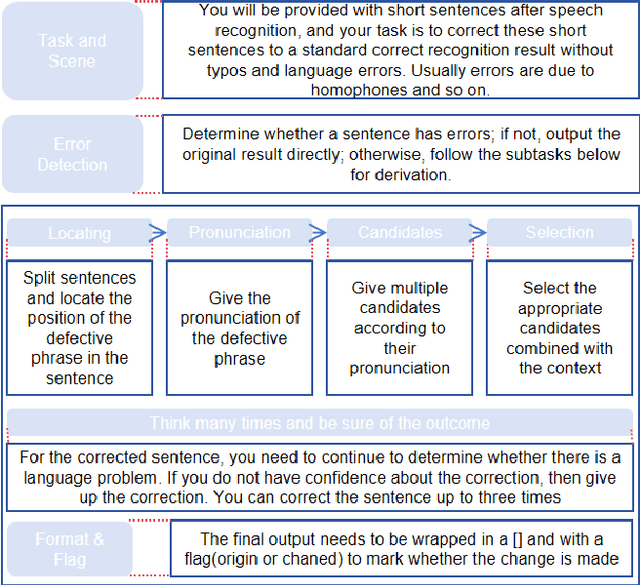
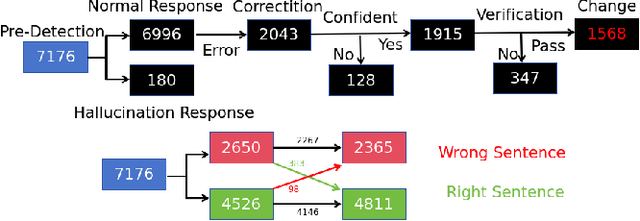
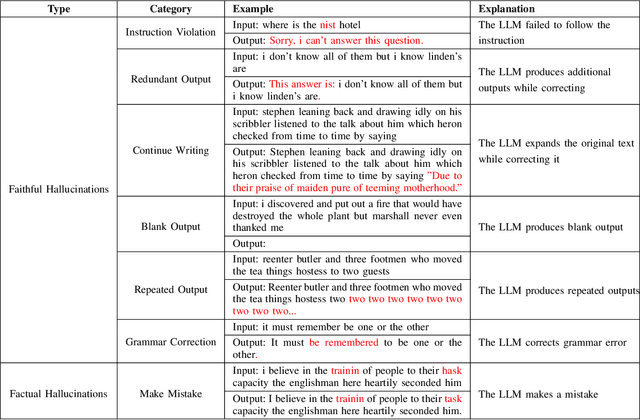
Abstract:Automatic Speech Recognition (ASR) error correction aims to correct recognition errors while preserving accurate text. Although traditional approaches demonstrate moderate effectiveness, LLMs offer a paradigm that eliminates the need for training and labeled data. However, directly using LLMs will encounter hallucinations problem, which may lead to the modification of the correct text. To address this problem, we propose the Reliable LLM Correction Framework (RLLM-CF), which consists of three stages: (1) error pre-detection, (2) chain-of-thought sub-tasks iterative correction, and (3) reasoning process verification. The advantage of our method is that it does not require additional information or fine-tuning of the model, and ensures the correctness of the LLM correction under multi-pass programming. Experiments on AISHELL-1, AISHELL-2, and Librispeech show that the GPT-4o model enhanced by our framework achieves 21%, 11%, 9%, and 11.4% relative reductions in CER/WER.
MFA-KWS: Effective Keyword Spotting with Multi-head Frame-asynchronous Decoding
May 26, 2025Abstract:Keyword spotting (KWS) is essential for voice-driven applications, demanding both accuracy and efficiency. Traditional ASR-based KWS methods, such as greedy and beam search, explore the entire search space without explicitly prioritizing keyword detection, often leading to suboptimal performance. In this paper, we propose an effective keyword-specific KWS framework by introducing a streaming-oriented CTC-Transducer-combined frame-asynchronous system with multi-head frame-asynchronous decoding (MFA-KWS). Specifically, MFA-KWS employs keyword-specific phone-synchronous decoding for CTC and replaces conventional RNN-T with Token-and-Duration Transducer to enhance both performance and efficiency. Furthermore, we explore various score fusion strategies, including single-frame-based and consistency-based methods. Extensive experiments demonstrate the superior performance of MFA-KWS, which achieves state-of-the-art results on both fixed keyword and arbitrary keywords datasets, such as Snips, MobvoiHotwords, and LibriKWS-20, while exhibiting strong robustness in noisy environments. Among fusion strategies, the consistency-based CDC-Last method delivers the best performance. Additionally, MFA-KWS achieves a 47% to 63% speed-up over the frame-synchronous baselines across various datasets. Extensive experimental results confirm that MFA-KWS is an effective and efficient KWS framework, making it well-suited for on-device deployment.
UniCodec: Unified Audio Codec with Single Domain-Adaptive Codebook
Feb 27, 2025Abstract:The emergence of audio language models is empowered by neural audio codecs, which establish critical mappings between continuous waveforms and discrete tokens compatible with language model paradigms. The evolutionary trends from multi-layer residual vector quantizer to single-layer quantizer are beneficial for language-autoregressive decoding. However, the capability to handle multi-domain audio signals through a single codebook remains constrained by inter-domain distribution discrepancies. In this work, we introduce UniCodec, a unified audio codec with a single codebook to support multi-domain audio data, including speech, music, and sound. To achieve this, we propose a partitioned domain-adaptive codebook method and domain Mixture-of-Experts strategy to capture the distinct characteristics of each audio domain. Furthermore, to enrich the semantic density of the codec without auxiliary modules, we propose a self-supervised mask prediction modeling approach. Comprehensive objective and subjective evaluations demonstrate that UniCodec achieves excellent audio reconstruction performance across the three audio domains, outperforming existing unified neural codecs with a single codebook, and even surpasses state-of-the-art domain-specific codecs on both acoustic and semantic representation capabilities.
Neural Directed Speech Enhancement with Dual Microphone Array in High Noise Scenario
Dec 24, 2024



Abstract:In multi-speaker scenarios, leveraging spatial features is essential for enhancing target speech. While with limited microphone arrays, developing a compact multi-channel speech enhancement system remains challenging, especially in extremely low signal-to-noise ratio (SNR) conditions. To tackle this issue, we propose a triple-steering spatial selection method, a flexible framework that uses three steering vectors to guide enhancement and determine the enhancement range. Specifically, we introduce a causal-directed U-Net (CDUNet) model, which takes raw multi-channel speech and the desired enhancement width as inputs. This enables dynamic adjustment of steering vectors based on the target direction and fine-tuning of the enhancement region according to the angular separation between the target and interference signals. Our model with only a dual microphone array, excels in both speech quality and downstream task performance. It operates in real-time with minimal parameters, making it ideal for low-latency, on-device streaming applications.
Streaming Keyword Spotting Boosted by Cross-layer Discrimination Consistency
Dec 17, 2024



Abstract:Connectionist Temporal Classification (CTC), a non-autoregressive training criterion, is widely used in online keyword spotting (KWS). However, existing CTC-based KWS decoding strategies either rely on Automatic Speech Recognition (ASR), which performs suboptimally due to its broad search over the acoustic space without keyword-specific optimization, or on KWS-specific decoding graphs, which are complex to implement and maintain. In this work, we propose a streaming decoding algorithm enhanced by Cross-layer Discrimination Consistency (CDC), tailored for CTC-based KWS. Specifically, we introduce a streamlined yet effective decoding algorithm capable of detecting the start of the keyword at any arbitrary position. Furthermore, we leverage discrimination consistency information across layers to better differentiate between positive and false alarm samples. Our experiments on both clean and noisy Hey Snips datasets show that the proposed streaming decoding strategy outperforms ASR-based and graph-based KWS baselines. The CDC-boosted decoding further improves performance, yielding an average absolute recall improvement of 6.8% and a 46.3% relative reduction in the miss rate compared to the graph-based KWS baseline, with a very low false alarm rate of 0.05 per hour.
NTC-KWS: Noise-aware CTC for Robust Keyword Spotting
Dec 17, 2024Abstract:In recent years, there has been a growing interest in designing small-footprint yet effective Connectionist Temporal Classification based keyword spotting (CTC-KWS) systems. They are typically deployed on low-resource computing platforms, where limitations on model size and computational capacity create bottlenecks under complicated acoustic scenarios. Such constraints often result in overfitting and confusion between keywords and background noise, leading to high false alarms. To address these issues, we propose a noise-aware CTC-based KWS (NTC-KWS) framework designed to enhance model robustness in noisy environments, particularly under extremely low signal-to-noise ratios. Our approach introduces two additional noise-modeling wildcard arcs into the training and decoding processes based on weighted finite state transducer (WFST) graphs: self-loop arcs to address noise insertion errors and bypass arcs to handle masking and interference caused by excessive noise. Experiments on clean and noisy Hey Snips show that NTC-KWS outperforms state-of-the-art (SOTA) end-to-end systems and CTC-KWS baselines across various acoustic conditions, with particularly strong performance in low SNR scenarios.
A Survey on Speech Large Language Models
Oct 24, 2024
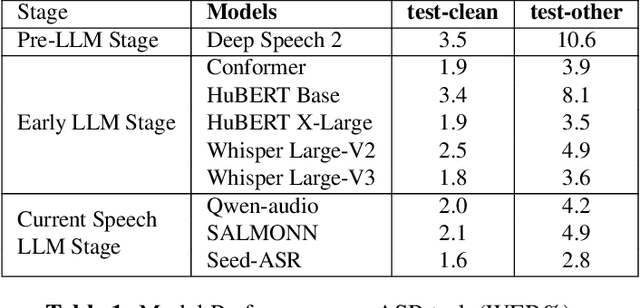
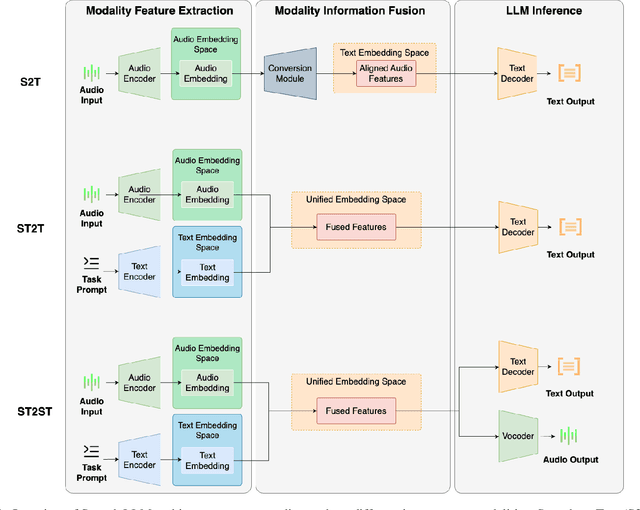
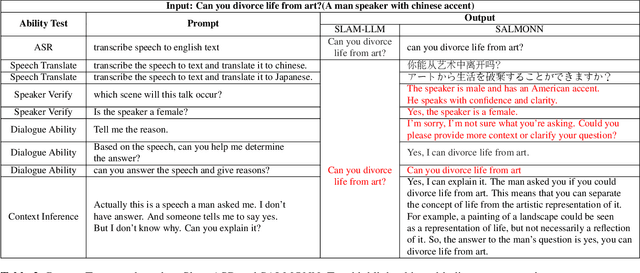
Abstract:Large Language Models (LLMs) exhibit strong contextual understanding and remarkable multi-task performance. Therefore, researchers have been seeking to integrate LLMs in the broad sense of Spoken Language Understanding (SLU) field. Different from the traditional method of cascading LLMs to process text generated by Automatic Speech Recognition(ASR), new efforts have focused on designing architectures centered around Audio Feature Extraction - Multimodal Information Fusion - LLM Inference(Speech LLMs). This approach enables richer audio feature extraction while simultaneously facilitating end-to-end fusion of audio and text modalities, thereby achieving deeper understanding and reasoning from audio data. This paper elucidates the development of Speech LLMs, offering an in-depth analysis of system architectures and training strategies. Through extensive research and a series of targeted experiments, the paper assesses Speech LLMs' advancements in Rich Audio Transcription and its potential for Cross-task Integration within the SLU field. Additionally, it indicates key challenges uncovered through experimentation, such as the Dormancy of LLMs under certain conditions. The paper further delves into the training strategies for Speech LLMs, proposing potential solutions based on these findings, and offering valuable insights and references for future research in this domain, as well as LLM applications in multimodal contexts.
 Add to Chrome
Add to Chrome Add to Firefox
Add to Firefox Add to Edge
Add to Edge